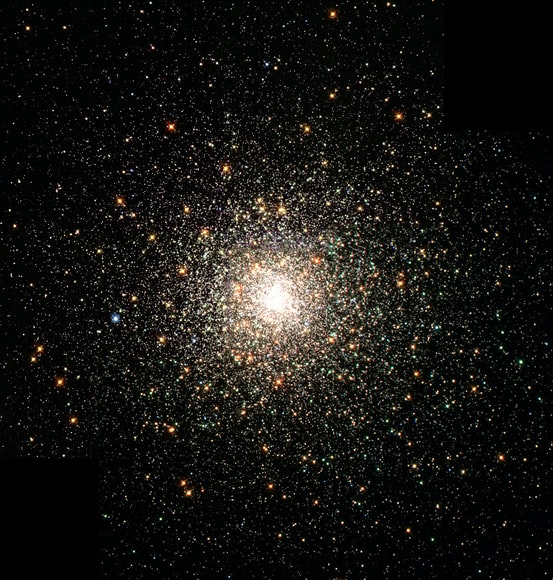Bites of Life: The mystery of missing matter

February 24, 2022
“Far out in the uncharted backwaters of the unfashionable end of the western spiral arm of the Galaxy lies a small unregarded yellow sun. Orbiting this at a distance of roughly 92 million miles is an utterly insignificant little blue green planet whose ape-descended life forms are so amazingly primitive that they still think digital watches are a pretty neat idea.”
Thus begins the hit science fiction novel, “A Hitchhiker’s Guide to the Galaxy.” This intro captures both mankind’s curiosity and the limitations of our current understanding of the realm beyond our planet.
Galaxies are hard to define, but Macalester’s physics department chair John Cannon describes them as “a gravitationally bound collection of gas, dust, stars with enough mass to hold it all together.”
Just as the Earth would fly off into space without the gravity of the sun’s mass to keep it in orbit, astronomers suspect that spiral galaxies are rotating around a bulge of older, faded or dead stars with a supermassive black hole at the center. However, astronomers have found that when we empirically add up all of the visible matter, the total doesn’t even come close to the necessary threshold that could hold the galaxy cluster together.
“We’re way off. We’re not even in the ballpark. It appears as though the majority [of mass] is stuff we’re not seeing” said Christopher West, a visiting assistant professor of astronomy and physics.
Even considering darker, less visible stars, space gas and dust, the mass we see just doesn’t account for galaxies’ cohesion at such a rotational velocity.
“These [objects] may not emit light or shine, but if those things exist between us and something that [does emit light], then the light will shine off of the dust or gas out there. That can be observed. You can do all of these calculations and find that there’s just not enough mass there. It’s wrong.” West said. “Whatever this stuff is, it isn’t interacting with the light because if it did we’d see it. If 85% of the mass of the galaxy is not responding with light, that’s obvious.”
“[Galaxies are] rotating too fast to be held together by only the mass we can see… There is not enough normal matter to account for the signature of gravity that the rotation provides for us,” Cannon said.
Initially, astrophysicists thought they were just missing some normal matter in their calculations. They thought there were potentially dense balls of mass (called MACHOs, massive compact halo objects) in the form of black holes, failed stars or planets that simply appeared dark and were thus hard to see.
“It’s probably not MACHOs. Folks can kind of put estimates on how many of these we really think are out there. There’s just not nearly enough unless there’s some little tiny blacks holes,” West said.
This either means that we have physics all wrong, and Newton’s laws don’t apply at such an astronomical scale, or there are yet undiscovered particles scattered throughout our universe. According to Cannon, these particles could be considered dark matter.
“This dark matter strongly outweighs normal matter, and is a fundamental part of our universe,” Cannon said. “We saw this in one galaxy, we saw it in ten galaxies, we saw it in thousands of galaxies and now the evidence is overwhelming. This component is real.”
Dark matter is difficult to define; astrophysicists know more about what it is not than what it is. Dark matter particles do not interact with electromagnetic force, so they do not reflect light (hence the name “dark”). At the same time, they do not absorb light, so “transparent matter” may be a more appropriate title. This means that the gravitational pull cannot be attributed to “non-luminous” or shaded normal matter, which would absorb radiation (dark matter does not). Dark matter is electrically neutral, and observations of colliding clouds of mass in space have shown us that it does not interact much with itself or with normal matter. Dark matter is also incredibly abundant. NASA estimates that the universe is made up of 68% dark energy, around 27% dark matter and about 5% normal matter. The science magazine, Nature, estimates that 85% of the universe’s mass is dark matter.
Other complex techniques such as gravitational lensing provide evidence for the existence of dark matter. The gravity from large concentrations of mass can distort space and magnify light from distant galaxies behind it. NASA’s Hubblesite compares this effect to a magnifying glass made out of gravity. This technique can be used to look for darker stars or planets, or to evidence the existence of dark matter.
“It’s ironic and humbling that, as an astrophysicist… After all these years of many brilliant people working around the world, solving this problem, we still don’t know what dark matter is,” Cannon said.
Astrophysicists have been running theoretical and physical experiments to find out what dark matter could be. They have several potential candidates for what they call “dark matter carriers,” or particles that could fit the behavior of this substance and explain the phenomena of missing matter. According to an assessment by Cornell University, the most popular dark matter candidates include WIMPs (weakly interacting massive particles), axions (low-mass, neutral slow-moving particles), Kaluza-Klein particles (hypothetical particles connected to string theory) or gravitinos (hypothetical particles related to general relativity and “supersymmetry” theories). Some of these particles fall outside of normal, observed matter called baryonic matter.
“A baryon is anything made of… protons, neutrons, electrons, atoms, things that we can make sense of,” Cannon said. Normal matter follows the standard model of physics, which describes elements of the universe along the terms of matter (fermions) and forces (bosons). WIMPs, axions, Kaluza-Klein particles and gravitinos are still theoretical, and they haven’t been discovered in the natural world.
“People are carrying out quite exotic experiments, trying to understand whether these hypothetical particles could be dark matter carriers,” Cannon said. “Those results have been ambiguous up until this point. So far, it’s still a mystery.”
There is an alternative hypothesis that dark matter does not exist, and that maybe our understanding of physics is flawed. Some astrophysicists believe that Einstein’s theory of general relativity and Newton’s laws do not apply at such a large scale. This theory is called MOND, or modified Newtonian dynamics, and it assumes that at the galactic scale, gravity drops off according to distance rather than distance squared (the standard formula for gravitational pull). This overturns the modern understanding of physics at its most basic level.
“The widespread, more or less accepted explanation is that there is a non luminous component, we just haven’t found it yet” Cannon said.
Macalester’s Physics and Astronomy Department will be offering non-calculus based courses in Introductory Physics I and II for students who don’t necessarily have the background in calculus, but crave more physics exploration and want to learn more about all things dark matter.
“Hopefully in our lifetime, there will be a magnificent leap forward in humanity’s understanding of this. The discovery of what dark matter is will be one of the most important discoveries ever made by humanity. It’s a really majestic problem.”











